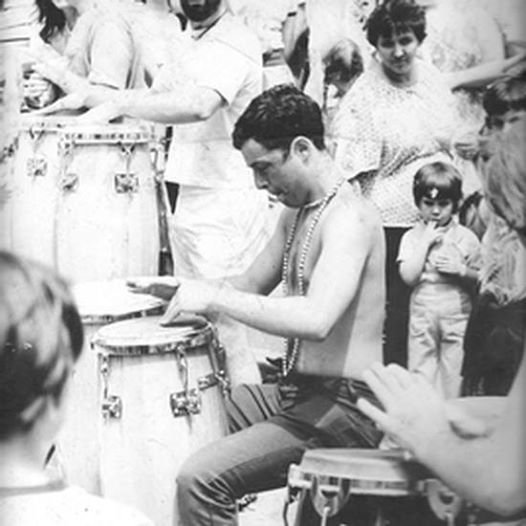Then And Now~ Let’s Get It Together!
When I first started drumming in the 70’s (for those of us not born into or of the drum culture), there was one general drummers informational grid or network, that is to say one large drumming platform or base of information that was available to the general public. It was very limited. It is so hard to conceive as today we have such an overwhelming wealth of information available on the computer and at our finger tips.
But back in the day it was very hard to find information and to study about drumming. There were no books available or videos. You needed a qualified teacher or class to play in. You had to know someone who knew someone and you needed to be interviewed just to get not a class that taught traditional drumming. On the east coast it just was not all out in the open like it is today. If you were around back then you know what i am talking about. In the early 70’s there were no conga teachers where I lived so I took drum set lessons.
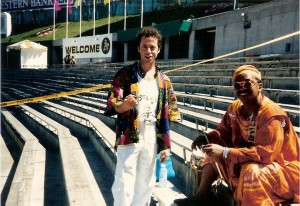
There were small very locked out learning scenarios or “grids” for the beginning of the west african scene but for most of us it was the drumming off of albums or record albums such as Mongo Santamaria or Olatunji that became the basis of our informational playing systems.
What we played was off of records or from the few and far between people who had actual teachers represented from various cultures. Almost no one had traveled to Cuba or west africa yet that i knew back then.
People, (drummers and friends) when we came together would share information and bring rhythms we had studied, discovered or heard from others and we would compare notes and learn from each other. This went on for many years before the internet. Personal sharing between friends and fellow students. There was a certain beauty to it, the passing of information from one drummer to another interpersonally. It is much different then learning off of the internet.
There was no other system of reference until cassette recorders became popular and affordable but that was not until in the mid to late 70’s and early 80’s. Eventually in 1985 the first home video camcorders came out by Sony and we took two to Cuba where we were some of the first non commercial americans to film folkloric drumming at our classes, demos and at performances we attended.
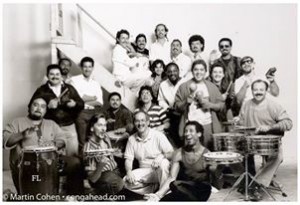
Back in the day, prior to internet in the USA, a drumming session would or could include a Congolese rhythm, Afro Cuban, Haitian or Senegalese. I do not remember anyone at any time saying, “Hey , i don’t play that stuff”.
In the 70’s, studying was completely opposite what it is today. As I mentioned there was no internet, videos or system of learning or sharing visually with out going to a friend or teacher.
Because of the lack of information available as it is today we all learned and happily played and embraced a large variety of rhythms from various orgins.
There were no instruments other then commercial conga drums and no djembes available to the public in music stores nor were there ethnically specific drums from their homeland (no Fed Ex!) at first.
If we played west african rhythms we had to play them on congas. The same with Brazilian rhythms. You did not have the opportunity to say, “no I don’t like rhythms from this place or that place, I only play this or that” like we do today. There was much more tolerance or ethnic diversity in rhythms.
It amazes me today how we have splintered in to so many small specific and sometimes intolerant groups or “grids”. It is great to specialize and i appreciate and support that and at the same time I am often surprised how short sighted and close minded we can all be when it comes to appreciating other drumming styles , cultures or systems.
We need to remember the source and beginning of the drum systems we are playing. No matter what system of drumming you are playing be it Cuba, Brazil, Haiti or other places..it originated in the African diaspora. Yes you can say it came from mars or Egypt or even UFO’s (if you must. But my point is the systems we are all playing now can be directly traced AT LEAST to West Africa.
Simbo (Craig Goodman) an early pioneer, teacher, performer, poet, dancer and all African based artist/artisan taught traditional based rhythms but also created rhythms based on his own studies from teachers and records he had studied. Some of his creations and rhythms such as Shiko and Camberto are widespread around the world in various drum communities. These rhythm creations or adaptations were melodic and took in account the fact that all drumming music comes from Africa.
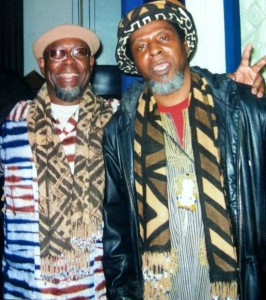
If you are playing a rhythm with 6/8 bell it is the same as the 6/8 bell in any of the other forms of drum music. Even if you are playing rock in roll music, rock comes out of clave which comes out of cuba which comes directly from west africa and is also part of and connected to the 6/8 bell.
If someone is playing differently or outside of the system you believe to be the best or your favorite it does not mean they are wrong. If they do not use the same hand pattern that does not mean they are wrong.
If someone slaps the drum differently that does not mean your slap is better. If someone plays old school and you love new school that does not mean you or they are right or wrong. Just because you think your way is right way does not mean it is.
My suggestion is to broaden your perspective. Be open to change and always keep a beginners mind. Everyone has something to share and even the most elevated percussionist can learn from the most beginning student! We will always be students. Accept that and you will always be happy. And remember, “playing is playing”.
You may have a way you love to do things. And you might not like how someone else plays or their system. But being positive an open minded opens up a whole new world of music no matter who you are, your playing level or style. To simply say someone else is wrong, does not know with out backing it up with positive support and knowledge in my book is unproductive and of no use. They are not going to hear it.
Drumming is music, music is love. Music is our art. You do not need to be from the culture to be an artist. Great musicians, great artists people that have love and express love and joy for their art do not berate others. They do not have to. They find ways to support others. At least this is my experience. Negativity and intolerance is not useful. Find ways to bridge gaps. Find ways to educate others.
We live in a world of mixed and merging cultures, philosophies and systems.
Instead of fighting with others over who is right and who is wrong, how to do it my way or your way, why not try being more accepting of others?

Although we are all playing different drums, be it bongos, djembe, congas, timbales or surdo they are all very closely related. All that is different is how they have fused away from the source. Instead of only staying and studying how different it is..I also suggest checking out how similar it all is.
I am not saying if you are a strict old school salsesro that you should study village style djembe rhythms, i am just saying to be open minded to each other and realize we are all playing music from the same source, we all have equal love for it.
When i make a comparison video be it congas, djembe or bongos it is only to show how good all the different drums sound. It’s not really about one being better then the other. It’s about what do you like and what do you like to hear? The beauty is we are all different and we all like to hear, play, see and do different things.
I am a beginner, a student of drum art who loves to study and also to share what I learn and discover. I do not pretend to be anything else. And I would like to see us all getting together, playing and sharing more. It’s as simple as that.
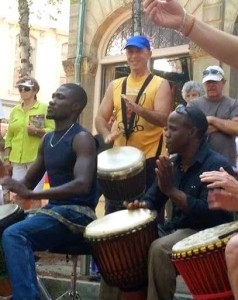
This post is not here or meant to criticize others, it is to propose that we all find more tolerance and open to the possibilities of sharing more with each other.
We all have so much to share, and we can learn much from each other. With live in a world with so much information is available to us at all times. Welcome in new rhythms and styles from others and don’t be afraid to learn!
Please check out the video link of Johnny Mendoza playing bongo with Sammy Davis Junior. To me this directly bridges to West African derived drum music. When Johnny explodes in colorful, powerful bursts and riffs it could just as easily be on a djembe as well.
https://youtu.be/00VB_fSRhQY
Here is a video, one of the first non commercial rumba videos shot i did in 1985 in Havana Cuba: https://www.youtube.com/watch?v=fyKJmDlD-w0

